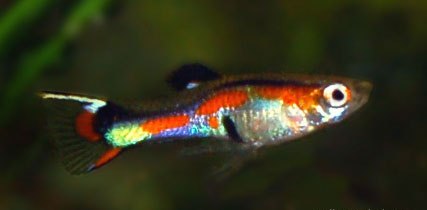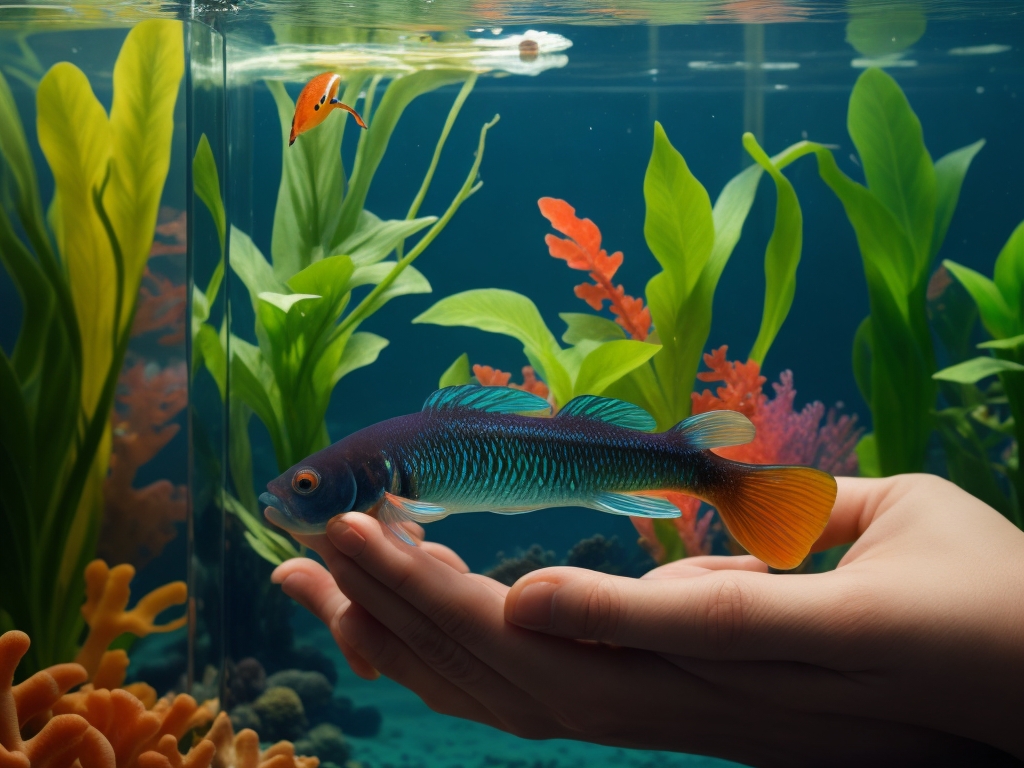Endler’s Livebearers are a small species of tropical fish native to South America. They are attractive, hardy, and easy to care for, making them a popular choice for both novice and experienced aquarists.
This guide will provide a comprehensive overview of the care requirements and other important facts about Endler’s Livebearers, such as appearance, behavior, lifespan, tank requirements, tank mates, diet and feeding, and breeding.
Overview and Quick facts
Here are some quick facts about Endlers Livebearer:
- Description:
- Lifespan:
- Habitat:
- Diet:
- Behavior:
- IUCN Red List Status:
- Not evaluated5.
- Other Names:
- Aquarium Care:
- Requires a minimum tank size of 10 gallons for a small group of individuals15.
- Water temperature should be kept between 68-82°F, with a pH range of 6.5-8.5 and almost any water hardness16.
- Regular water changes and maintenance are necessary to maintain optimal water quality6.

Despite their diminutive size, Endlers Livebearers require dedication and careful attention to provide a healthy environment for them to thrive.
Endlers Livebearers, a type of fish native to the South American wetlands, are a popular addition to any aquarium due to their vibrant colors and ease of care. As they are a small species of fish, a tank size of at least 10 gallons is recommended. It is important to monitor the water temperature, as Endlers Livebearers prefer water temperatures between 74-78°F (23-26°C). Additionally, the pH level of the water should be kept between 7.0-8.0, and the hardness should be between 8-12°dGH.
Endlers Livebearers are small, peaceful, and non-aggressive, making them a great choice for community tanks. They should be kept in groups of five or more, and they do best when kept with peaceful tankmates such as smaller tetras or Corydoras.

Endlers Livebearers are omnivorous, and they should be provided a diet of high-quality flakes, pellets, and frozen or live food. It is essential to maintain a clean tank, as poor water quality can lead to health problems and can even cause the fish to become stressed. Regular water changes and regular tank maintenance will ensure that your Endlers Livebearers remain healthy and happy.
Appearance & Behavior
Endlers Livebearers are easily recognized by their vibrant colors and small size; they typically grow to about 1.5 inches in length. They are peaceful and social fish, and enjoy being kept in groups of at least 6-8. Endlers will often change colors depending on their moods and environment. This range of coloration includes hues of greens, blues, yellows, and even reds.
Endlers are very active and social, and will often school together. They also love to interact with their owners, and will often swim up to the glass when they see them. They are also very hardy and can adapt to a variety of water conditions. This makes them a great choice for beginner aquarists.
Endlers are also known to display interesting behaviors such as chasing and socializing with one another. They will also occasionally change color, appearing more vibrant when they are happy.
The lifespan of Endlers Livebearers can vary from 2-4 years in the aquarium. This makes them a great option for those looking for a fish that will provide years of enjoyment. With the right care, Endlers can live a long and happy life.
With this in mind, let’s move onto the next section and discuss the best way to care for your Endlers Livebearers.
Lifespan
With proper care, Endlers Livebearers can enjoy a lifespan of up to 4 years. Providing a healthy and safe environment is key to ensuring they reach their full life expectancy. Maintaining water quality is essential to their well-being and should be checked regularly.
| Factors | Impact |
|---|---|
| Water Quality | Poor quality can cause sickness or death |
| Temperature | Too much variance can lead to stress |
| Nutrition | Poor nutrition leads to poor health |
| Environment | Crowding can lead to disease |
| Disease | Can lead to early death |
Care and tank requirements
To ensure your Endlers Livebearers remain healthy and thrive, proper care and tank requirements must be met. Tank size is an important factor in maintaining a healthy, happy environment for your Endlers. A minimum of 10 gallons is recommended for a small group of Endlers, but larger tanks are preferred. The tank should also have plenty of live plants and hiding places for the fish.
Water quality is also essential for Endlers. The water should be kept at a temperature between 72-78 degrees Fahrenheit, with a pH level between 6.5-7.5. Regular water changes should be done every 1-2 weeks, and the water should be dechlorinated before use. Additionally, an aquarium water conditioner should be used to ensure good water quality.
In order to ensure the best care for your Endlers, you should also provide a quality diet. A variety of live, frozen, and freeze-dried foods should be offered to ensure they are getting all the nutrients they need. Feeding should be done twice a day in small amounts.
Finally, regular tank maintenance is key to keeping your Endlers healthy. All debris and leftover food should be removed from the tank, and the filter should be cleaned every 2-4 weeks. Regular water testing should also be done to keep track of water parameters.
With proper tank size, water quality, diet, and maintenance, your Endlers Livebearers will be sure to thrive in their new home.
Tank Mates
When it comes to tank mates, Endlers Livebearers should be kept with other peaceful, small fish that require similar water parameters. A diversity of species can be added, although too many different kinds can cause tension in the tank. It is important to establish a harmonious environment, and this means not overcrowding the tank. Some possible tank mates for Endlers Livebearers include neon tetras, guppies, platies, and various small, peaceful catfish.
Here are some suitable options:
- Other small, peaceful community fish such as tetras (Neon Tetra, Ember Tetra), rasboras (Harlequin Rasbora, Chili Rasbora), and small corydoras catfish.
- Guppies: Endlers Livebearers are closely related to guppies and can be housed together without issues.
- Dwarf shrimp: Shrimp like Cherry Shrimp or Amano Shrimp make great tank mates for Endlers Livebearers as they will not bother each other.
- Snails: Snails like Nerite Snails or Mystery Snails can be a good addition to the tank since they help clean the aquarium.
When choosing tank mates, it is important to research the fish and check that the water parameters are compatible. Endlers Livebearers prefer water temperatures of around 24°C (75°F), pH of 7.2-7.6, and a hardness of 5-20 dH. Maintaining a diverse selection of tank mates while still ensuring harmony is key. Avoid mixing Endlers Livebearers with aggressive species, such as cichlids, which can cause stress and injury.
Diet and Feeding
For optimal health, Endlers Livebearers require a diverse diet comprising various food types to receive all essential nutrients. Implementing a feeding schedule that aligns with their natural foraging habits is crucial. It’s recommended to feed them multiple times daily but in small portions. Here’s a structured guide to their dietary needs:
Types of Food:
- Live Food:
- Small insects
- Artemia (brine shrimp)
- Mosquito larvae
- Dry Food:
- Flakes
- Pellets
- Freeze-Dried Food
Feeding Guidelines:
- Ensure live food is adequately small for Endlers’ consumption.
- Monitor water conditions, keeping an eye out for pollution caused by decaying leftovers.
- Avoid overfeeding, as it can precipitate health complications and deteriorate water quality.
Regularly monitoring the water quality is paramount, as neglecting this can lead to unfavorable conditions resulting from uneaten food remnants. Overfeeding is a common mistake that not only affects the health of the fish but also compromises the aquatic environment. Adhering to the suggested food varieties and maintaining consistent checks on the water quality will significantly contribute to the wellbeing of the Endlers Livebearers. When cared for properly, these fish can enjoy extended and healthy lifespans.
Breeding
Once the Endlers have matured, they can be bred if the proper conditions are provided. Breeding Endlers can be a rewarding experience, both for the experienced fish keeper and for the fish themselves. To maximize the success of breeding, it is important to know how to create a suitable environment for the fish. A good setup should include a temperature of around 75-80°F, a pH around 7.0, and a hardness of around 10-20 dGH. The tank should also contain plenty of hiding places and no sharp objects that may injure the fish.
Endlers can be divided into different breeding strains, and it is important to choose the right one for the tank. Endlers bred in captivity can quickly lose their color and pattern, so it is important to source fish from a reliable supplier. Additionally, it is important to consider the environmental impact of the fish. Endlers that are bred in captivity are more likely to survive in the wild, and while they may not be as colorful as those bred in captivity, they can still thrive in their natural environment.

